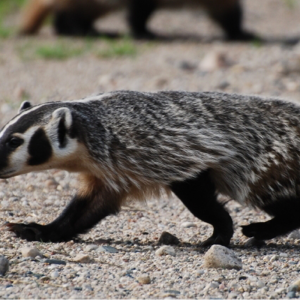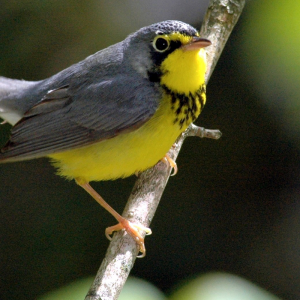Grue blanche
Vital Signs
Common name: Whooping Crane
Latin name: Grus americana
Status under SARA: Endangered, 2010 COSEWIC assessment: Endangered
Range: The original flocks of Whooping Cranes nest in Wood Buffalo National Park, located on the Alberta-Northwest Territories border, and migrate to the Texas Gulf Coast and winter in or near the Aransas National Wildlife Refuge. An additional flock of Whooping Cranes nests in southeastern Idaho and winters in the middle Rio Grande Valley of New Mexico. A non-migratory wild flock lives in Florida.
Life Span: 22-30 years
Size: Adults are 1.5 m tall and weigh between six and seven kilograms.
Population Estimate: Wood Buffalo National Park: 220 birds and increasing. Florida: 60 birds, stable to decreasing.
The Facts
- Whooping Cranes are naturally wary and aggressive, and cannot tolerate human disturbance.
- Pairs usually mate for life and return to the same nest site each year. The average nesting territory is large, from 400 to 7,000 ha. They build their nests with bulrushes in shallow swampy areas.
- During nesting (but never flight) they make a wild bugling sound that can be heard from five kilometres away.
- They lay two eggs, but only one chick survives. Chicks are born in early June and are as big as their parents three months later. Chicks are rusty brown and slowly fade through their first year.
- Favourite foods are insects, seeds, roots, crabs, clams, and snails. During migration, they will eat grains from farm crops.
- Using an energy-efficient combination of spiralling and gliding, whoopers have been known to fly nonstop for 10 hours, covering 750 km.
- The Whooping Crane is the tallest bird in North America, standing almost 1.5 m tall with a two-metre wingspan. This beautiful bird has a pure white body and tail except for a bright red crown and a black “mustache,” black wingtips and long black legs.
The Story
The Whooping Crane is one the oldest birds on earth. Fossils dating back 3.5 million years are identical to the modern “whooper.” This magnificent bird, which survived millions of years of planetary change, became gravely endangered after only a few hundred years of European settlement in North America. The Whooping Crane once nested over most of central and western North America, and was commonly seen stopping over at large marshes in the interior of the continent while migrating south. Today, the majority of whoopers breed in Wood Buffalo National Park, located along the border of Alberta and the Northwest Territories, and they winter only in a small marsh on the coast of Texas.
Being very large birds, Whooping Cranes need very large places to live. As humans settled in the North American prairies, they drained marshes for crops and pastures and in doing so destroyed the whooper’s home. The only remaining winter habitat is a very narrow strip of marsh on the Texan coast. This area is getting smaller every year because of industrial, urban, and recreational developments. Every year, there are fewer large marshes left in central North America for the birds to rest and feed in during their 4,000 km migration.
By 1941, there were only 21 Whooping Cranes left on earth. Of these, six died in a Louisiana hurricane, leaving 15 whoopers struggling to preserve the species. By 1979, the population had grown to 75 birds and in 1995 the number had reached 155.
The number of whoopers in the Wood Buffalo National Park/Aransas National Wildlife Refuge flock has increased by at least 35 percent in the last 10 years and has a population growth of 3.7 percent per year.
In 2000, there were a total of 51 nesting pairs of cranes, with nine pairs that successfully arrived on the wintering grounds with a single young each. In 2006-07, the Wood Buffalo/Aransas population numbered 237 Whooping Cranes, including 45 chicks; both numbers were record highs. That winter there were 353 whoopers in the wild and 145 birds in captivity for a total world population of 498 Whooping Cranes. The Whooping Crane is determined to recover, but the only way it can is if we protect its habitat.
What is Being Done
Whooping Cranes are protected in Canada and the US under the Migratory Bird Convention Act. The breeding area in Wood Buffalo National Park is protected, and part of the wintering land in Texas has been a wildlife refuge since 1937. Several migration stopover areas have since been protected in the US.
Before 1996, there were several captive breeding programs in the United States that used wild whooper eggs from Wood Buffalo National Park. In 1995, there were 95 whoopers in captivity. Since then, enough eggs are produced at the captive breeding sites that collecting wild eggs is no longer necessary. The Calgary Zoo remains the only captive breeding site for whoopers in Canada.
There have been several cross-fostering experiments, where whooper eggs are placed with other crane flocks. In an attempt to increase the population, Whooping Crane eggs were put into the nests of Sandhill Cranes in Gray’s Lake National Wildlife Refuge in Idaho, and the Sandhill Cranes raised the young whoopers as their own. Unfortunately, the whoopers thus raised had difficulty breeding with other Whooping Cranes and so the practice has been stopped.
In 1993, young whoopers were released in Florida in an attempt to start a new wintering area for the species. By 2004, a total of 221 whoopers had been released.
Ontario-based Operation Migration uses ultra-light aircrafts to guide Whooping Cranes from Wisconsin to new wintering areas in the United States. George Archibald, co-founder of the International Crane Foundation, is well known for successfully breeding, through the use of artificial insemination, a human-imprinted Whooping Crane named Tex by imitating the courtship dancing and behavior of a male crane. For his conservation efforts, Nature Canada awarded Archibald the Douglas Pimlott Award in 2007.
What You Can Do
- Learn about the Whooping Crane and pass your knowledge on to others to increase public concern for this endangered bird and its habitat.
- Support conservation groups working to save the Whooping Crane and its habitat.


